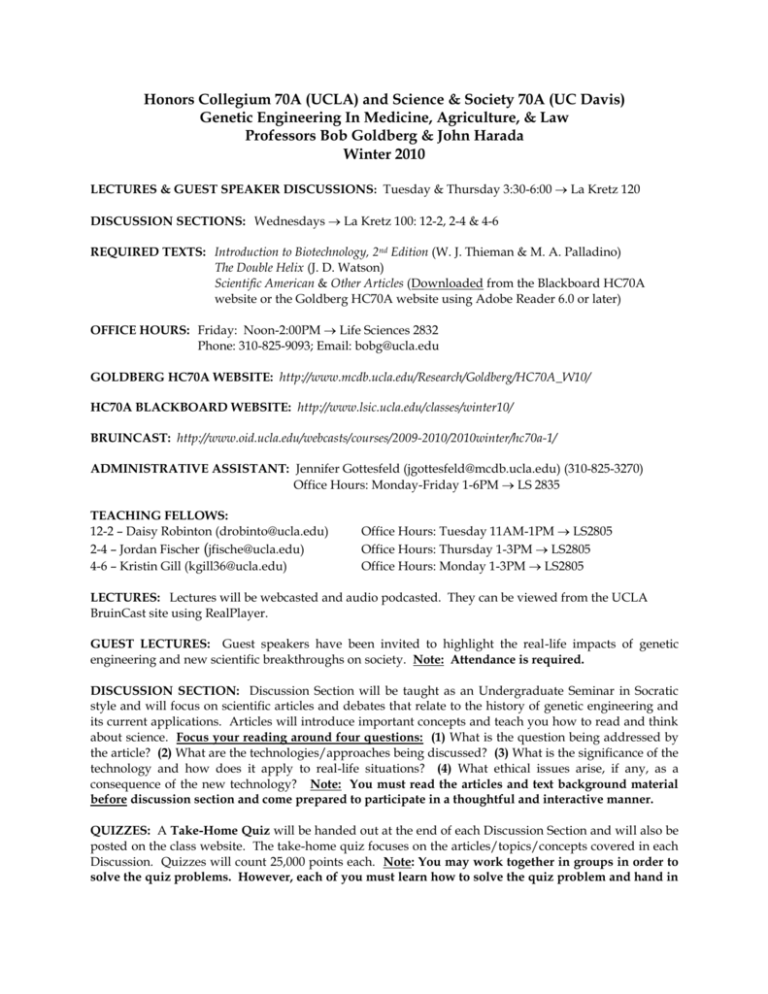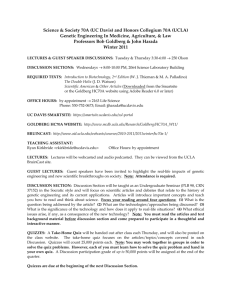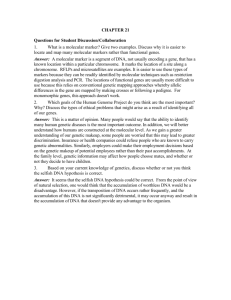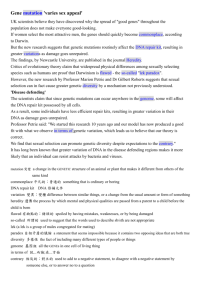DISCUSSION ONE – The Basics of Genetic Engineering
advertisement

Honors Collegium 70A (UCLA) and Science & Society 70A (UC Davis) Genetic Engineering In Medicine, Agriculture, & Law Professors Bob Goldberg & John Harada Winter 2010 LECTURES & GUEST SPEAKER DISCUSSIONS : Tuesday & Thursday 3:30-6:00 La Kretz 120 DISCUSSION SECTIONS: Wednesdays La Kretz 100: 12-2, 2-4 & 4-6 REQUIRED TEXTS: Introduction to Biotechnology, 2nd Edition (W. J. Thieman & M. A. Palladino) The Double Helix (J. D. Watson) Scientific American & Other Articles (Downloaded from the Blackboard HC70A website or the Goldberg HC70A website using Adobe Reader 6.0 or later) OFFICE HOURS: Friday: Noon-2:00PM Life Sciences 2832 Phone: 310-825-9093; Email: bobg@ucla.edu GOLDBERG HC70A WEBSITE: http://www.mcdb.ucla.edu/Research/Goldberg/HC70A_W10/ HC70A BLACKBOARD WEBSITE: http://www.lsic.ucla.edu/classes/winter10/ BRUINCAST: http://www.oid.ucla.edu/webcasts/courses/2009-2010/2010winter/hc70a-1/ ADMINISTRATIVE ASSISTANT: Jennifer Gottesfeld (jgottesfeld@mcdb.ucla.edu) (310-825-3270) Office Hours: Monday-Friday 1-6PM LS 2835 TEACHING FELLOWS: 12-2 – Daisy Robinton (drobinto@ucla.edu) 2-4 – Jordan Fischer (jfische@ucla.edu) 4-6 – Kristin Gill (kgill36@ucla.edu) Office Hours: Tuesday 11AM-1PM LS2805 Office Hours: Thursday 1-3PM LS2805 Office Hours: Monday 1-3PM LS2805 LECTURES: Lectures will be webcasted and audio podcasted. They can be viewed from the UCLA BruinCast site using RealPlayer. GUEST LECTURES: Guest speakers have been invited to highlight the real-life impacts of genetic engineering and new scientific breakthroughs on society. Note: Attendance is required. DISCUSSION SECTION: Discussion Section will be taught as an Undergraduate Seminar in Socratic style and will focus on scientific articles and debates that relate to the history of genetic engineering and its current applications. Articles will introduce important concepts and teach you how to read and think about science. Focus your reading around four questions: (1) What is the question being addressed by the article? (2) What are the technologies/approaches being discussed? (3) What is the significance of the technology and how does it apply to real-life situations? (4) What ethical issues arise, if any, as a consequence of the new technology? Note: You must read the articles and text background material before discussion section and come prepared to participate in a thoughtful and interactive manner. QUIZZES: A Take-Home Quiz will be handed out at the end of each Discussion Section and will also be posted on the class website. The take-home quiz focuses on the articles/topics/concepts covered in each Discussion. Quizzes will count 25,000 points each. Note: You may work together in groups in order to solve the quiz problems. However, each of you must learn how to solve the quiz problem and hand in your own quiz. A Discussion participation grade of up to 50,000 points will be assigned at the end of the quarter. Quizzes are due at the beginning of the next Discussion Section. CLASS RECEPTIONS & DINNERS: There will be a catered all-class reception for each guest speaker immediately following their Thursday lecture. This will give you an opportunity to interact with the speakers who are experts in their chosen fields. In addition, I will take groups of students to dinner throughout the quarter following the reception. The dinners will begin the first week in February, may also include the guest speakers, and will be a unique experience! Check the dinner group list that will be handed out in class for the week and day that you are scheduled to attend dinner. DOUBLE HELIX REPORT: You will write a short report on The Double Helix by J. D. Watson that will count 50,000 points. Guidelines will be handed out in class. The Double Helix Report is due at the beginning of class on Tuesday, January 19 (Week 3) EXAMS: Exams include a Take-Home Exam and two All-Class Oral Exams. Take-Home Exam questions will be handed out in class during Week 4 and will count 400,000 points. The mid-term oral exam will cover questions on the Take-Home Exam and will count 100,000 points. Final Oral Exam questions will be handed out in class during Week 9 and will count 175,000 points. The Exam Schedule is: Take-Home Exam: Due Thursday, February 11 at the beginning of class (Week 6) All-Class Mid-Term Oral Exam: Thursday, February 11, La Kretz 120 (Week 6) All-Class Final Oral Exam: Thursday, March 11, La Kretz 120 (Week 10) GRADING: You will be able to earn ONE MILLION regular points and a number of BONUS POINTS during the quarter. Your grade for this quarter will be based on 1,000,000 points, although you have the potential for earning more than 1,000,000 points. Regular points will be divided as follows: Double Helix Report Discussion Quizzes Discussion Participation Take-Home Exam Mid-Term Oral Exam Final Oral Exam TOTAL Total Points 50,000 200,000 50,000 400,000 125,000 175,000 1,000,000 % Grade 5 20 5 40 12.5 17.5 100 The following guidelines will be used to assign grades: A (>90%), B (80-89%), C (70-79%), D (60-69%), F (<60%). Your grade will be assigned using the following formula: % Total Points = [(Regular points + Bonus points)] X [100] [(1,000,000)] DATE 1/5 TOPIC Lecture 1: The Age of DNA: What is Genetic Engineering? Demonstrations: Isolating DNA & Classical Genetic Engineering 1/7 Film: Race for the Double Helix DISCUSSION 1: The Manipulation of Genes Potential Biohazards of Recombinant DNA Molecules Recombinant DNA Debate Lecture 2: What Are Genes & How Do They Work: Part One Demonstrations: Gel Electrophoresis & Bacteria "Cloning" DOUBLE HELIX REPORT QUESTIONS HANDED OUT BACTERIA “CLONING” GUIDELINES HANDED OUT 1/12 1/14 Speaker: Dr. Robert Wayne, PhD: Hunting For Dog Ancestors All-Class Reception DISCUSSION 2: Useful Proteins from Recombinant DNA Discovering Genes for New Medicines ----------------------------------------------------------------------------------------------------------------------------- --------------1/19 Lecture 3: What Are Genes & How Do They Work: Part Two Film: Kerry Mullis and PCR DOUBLE HELIX REPORT DUE 1/21 Speaker: Richard Hamilton, PhD: Engineering Plants For Biofuels All-Class Reception DISCUSSION 3: Transgenic Crops Sowing a Gene Revolution Grassoline at the Pump Debate: To Genetically Engineer Plants or Not? ----------------------------------------------------------------------------------------------------------------------------- --------------1/26 Lecture 4: How Are Genes Cloned & Engineered: The Factor VIII Story Demonstration: Making Your Own DNA Fingerprint! 1/28 Speaker: Alan McHughen, PhD: GMOs: What's All The Fuss TAKE-HOME EXAM QUESTIONS HANDED OUT All-Class Reception DISCUSSION 4: Chromosome Mapping With DNA Markers Keeping Your Genes Private Debate: DNA Testing in Medicine – To Regulate or Not? ----------------------------------------------------------------------------------------------------------------------------- --------------2/2 Lecture 5: The Age of Genomics: Your Personal Genome 2/4 Speaker: Harry Klann, Criminologist: DNA Forensics & The Law All Class Reception & Dinner 1 DISCUSSION 5: When Science Takes the Witness Stand The DNA Detectives CSI: Reality Debate: DNA & The Law – Privacy vs. Public Safety? ____________________________________________________________________________________________ DATE 2/9 TOPIC Lecture 6: Identifying Human Origins: Past & Present 2/11 TAKE HOME EXAM DUE ALL-CLASS MIDTERM ORAL EXAM Dinner 2 DISCUSSION 6: Transgenic Livestock As Drug Factories Cloning For Medicine The Land of Milk & Honey Debate: To Genetically Engineer Animals or Not? --------------------------------------------------------------------------------------- ----------------------------------------------------2/16 Lecture 7: 21st Century Genetic Engineering Applications UC Davis Students Visit UCLA (2/16-2/18) 2/18 Michele Evans, MD: In Vitro Fertilization & Genetic Testing All Class Reception & Dinner 3 DISCUSSION 7: The Future of Stem Cells The First Human Cloned Embryo Pandora's Baby Debate: To Regulate Stem Cell Research or Not? 2/23 Lecture 8: Human Genetic Engineering & Gene Therapy 2/25 Dr. Greg Stock PhD: All-Class Reception & Dinner 4 DISCUSSION 8: Gene Therapy Overcoming Obstacles to Gene Therapy What Cloning Means for Gene Therapy ----------------------------------------------------------------------------------------------------------------------------- --------------3/2 Lecture 9: Science & the Constitution: Regulating Science & GMOs 3/4 Speaker: Dr. John Novembre: Tracking Human Ancestry All-Class Reception & Dinner 5 DISCUSSION 9: Traces of a Distant Past Does Race Exist ------------------------------------------------------------------------------------------------------------------------------------------3/9 Lecture 10: Science & the Constitution: Who Owns Your Genes? Film Clip: Knowledge or Certainty Discussion 10: The Genetic Basis of Cancer The Magic of Microarrays Mapping the Cancer Genome ----------------------------------------------------------------------------------------------------------------------------- --------------3/11 FINAL ALL-CLASS ORAL EXAM All-Class Reception & Dinner 6 ------------------------------------------------------------------------------------------------------------------------------------------ -- TEXT READING ASSIGNMENTS FOR LECTURES AND DISCUSSIONS: Note: These chapters review all information related to the topics covered in each lecture and discussion PLUS additional topics. Concentrate on chapter sections related to lectures and discussion articles. INTRODUCTION TO BIOTECHNOLOGY, 2 ND EDITON LECTURE 1 Chapter 1 DISCUSSION 1 Chapters 2 & 3 --------------------------------------------------------------------------------------LECTURE 2 Chapter 2 DISCUSSION 2 Chapters 2, 3, & 5 --------------------------------------------------------------------------------------LECTURE 3 Chapter 2 DISCUSSION 3 Chapters 6, 12, & 13 ---------------------------------------------------------------------------------------LECTURE 4 Chapter 3 DISCUSSION 4 Chapters 8 & 11 ---------------------------------------------------------------------------------------LECTURE 5 Chapters 3, 8, & 11 DISCUSSION 5 Chapter 8 ----------------------------------------------------------------------------------------LECTURE 6 Chapter 8 DISCUSSION 6 Chapters 7, 12, & 13 ----------------------------------------------------------------------------------------LECTURE 7 Chapters 5, 6, & 7 DISCUSSION 7 Chapters 11 & 13 ----------------------------------------------------------------------------------------LECTURE 8 Chapter 11 DISCUSSION 8 Chapter 11 ----------------------------------------------------------------------------------------LECTURE 9 Chapter 12 DISCUSSION 9 Chapter 5 ----------------------------------------------------------------------------------------LECTURES 10 & 11 Chapters 12 & 13 DISCUSSION TEN Chapter 11 --------------------------------------------------------------------------------------------------------------------DISCUSSION SECTION BIBLIOGRAPHY: Note: These articles are required reading for Discussion Section. They can be downloaded from the HC70A class websites (Goldberg or Blackboard) and opened using Acrobat Reader 6.0 0r later. DISCUSSION ONE – The Basics of Genetic Engineering 1. Stanley N. Cohen, The Manipulation of Genes. Scientific American, July, 1975, 233 (1), 24-33. 2. Clifford Grobstein, The Recombinant DNA Debate. Scientific American, July, 1977, 237 (1) 22-33. 3. Paul Berg et al., Potential Biohazards of Recombinant DNA Molecules, Science, July 26, 1974, 185, 303 DISCUSSION TWO – Using Genetic Engineering to Make Drugs in Bacteria 1. Walter Gilbert and Lydia Villa-Komaroff, Useful Proteins From Recombinant Bacteria. Scientific American, April, 1980, 242 (4), 74-94. 2. William A. Haseltine, Discovering Genes For New Medicine. Scientific American, March, 1997, 276 (3), 9297. DISCUSSION THREE – Using Genetic Engineering to Make Better Crops 1. Charles S. Gasser and Robert T. Fraley, Transgenic Crops. Scientific American, June, 1992, 266 (6), 62-69. 2. Terri Raney and Prabhu Pingali, Sowing a Gene Revolution. Scientific American, September, 2007, 297 (3), 104-111. 3. George W. Huber and Brice E. Dale, Grassoline at the Pump, Scientific American, July, 2009, 301 (1), 5259. DISCUSSION FOUR – Identifying and Testing Human Disease Genes 1. Ray White and Jean-Marc Lalouel, Chromosome Mapping with DNA Markers. Scientific American, February, 1988, 258 (2), 40-48. 2. Mark A. Rothstein, Keeping Your Genes Private, Scientific American , September, 2008, 299 (3), 64-69. DISCUSSION FIVE – DNA Testing in the Courtroom 1. Peter J. Neufeld and Neville Colman, When Science Takes the Witness Stand. Scientific American, May, 1990, 262 (5), 46-53. 2. Jerry Adler and John McCormick, The DNA Detectives. Newsweek, November 16, 1998, pgs. 64-71. 3. Max H. Houck, CSI Reality. Scientific American, July, 2006, 295 (1), 85-89 DISCUSSION SIX – Genetic Engineering Farm Animals to Make Drugs 1. William H. Velander, Henryk Lubon, and William N. Drohan, Transgenic Livestock as Drug Factories. Scientific American, January 1997, 276 (1), 70-74. 2. Ian Wilmot, Cloning For Medicine. Scientific American, December 1998, 279 (6), 58-63. 3. Gary Stix, The Land of Milk & Honey, Scientific American, November 2005, 293 (5), 102-104. DISCUSSION SEVEN – Embryonic Stem Cells and Cloning for Medicine 1. Clive Cookson et al., The Future of Stem Cells. Scientific American Special Report, July, 2005, A6-A21. 2. Jose B. Cibelli, Robert P. Lanza, Michael West, and Carol Ezzell, The First Human Cloned Embryo. Scientific American, January, 2002, 286 (1), 44-51. 3. Robin Marantz Henig, Pandora’s Baby, Scientific American, June, 2003, 266 (6), 63-68. DISCUSSION EIGHT – Gene Therapy: Fixing Human Genetic Defects 1. Inder M. Verma, Gene Therapy. Scientific American, November, 1990, 263 (5), 68-84. 2. Theodore Friedman, Overcoming the Obstacles to Gene Therapy. Scientific American, June, 1997, 276 (6), 96-101. 3. Steve Mirsky and John Rennie, What Cloning Means for Gene Therapy? Scientific American, June, 1997, 276 (6), 122-123 DISCUSSION NINE – Tracing Human Origins 1. Gary Stix, Traces of a Distant Past, Scientific American, July, 2008, 298 (6), 56-63 2. Michael J. Bamshad and Steve E. Olsen, Does Race Exit? Scientific American, December, 2003, 289 (6), 78-85. DISCUSSION TEN – Understanding and Defeating Cancer 1. Webster K. Cavenee and Raymond L. White, The Genetic Basis of Cancer. Scientific American, March 1995, 273 (3), 72-79. 2. Stephen H. Friend and Roland B. Stoughton, The Magic of Microarrays. Scientific American, February, 2002, 286 (2), 44-53. 3. Francis S. Collins and Anna D. Barker, Mapping the Cancer Genome, Scientific American, March, 2007, 296 (3), 50-57.







